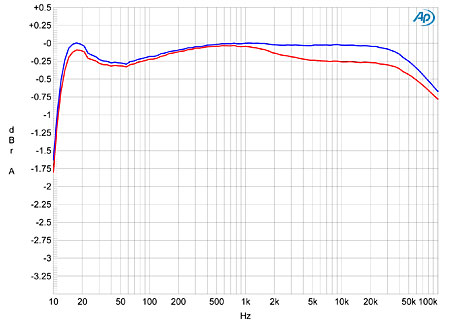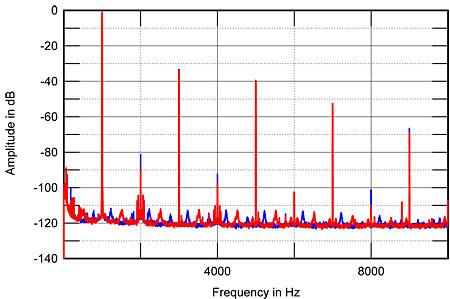| Columns Retired Columns & Blogs |
NAD PP 3 digital phono preamplifier Measurements
Sidebar 3: Measurements
I measured the NAD PP 3 with Stereophile's loaner Audio Precision SYS2722 system. (See www.ap.com and "As We See It" in the January 2008 issue.) I examined its performance both from its analog line outputs and in the digital domain, using the Mac version of the free VinylStudio Lite program supplied by NAD to create files from the PP 3's USB output fed to my Apple MacBook. The Mac USB Prober utility identified the NAD as "USB Audio Codec, Burr Brown from TI," and revealed that the A/D converter operates with 16-bit word lengths at sample rates of 32, 44.1, and 48kHz. The AudioMidi utility informed me that there were no input level controls.
Looking first at the PP 3's behavior as a line-level device, it offered unity gain and was non-inverting; ie, it preserved absolute polarity. The frequency response (not shown) was flat from 10Hz to 200kHz and was not affected by the load impedance. The input impedance was almost 100k ohms at all frequencies, and the output impedance a low 100 ohms at all frequencies. The line output jacks are buffered. Channel separation (not shown) was superb at >110dB below 2kHz, and still 100dB at 30kHz. This may be an inexpensive product, but its circuit design and layout don't reflect that fact.
An input of 2V RMS at 1kHz gave an indicated level of "63" on VinylStudio's meters, with 3.8V required to light the red "Clip" indicators. The same held at low frequencies, but at 20kHz it took a little less, 3.6V, to clip the A/D converter. As even the "hottest" line-level components rarely have maximum outputs above 3V, this is sensible design. At 3.8V output the distortion remained low, even into the demanding 600 ohm load (fig.1), with the third harmonic the highest in level, at –94dB (0.002%). The second harmonic lies at –110dB (0.0003%) in this graph. Increasing the load to 100k ohms dropped the second harmonic to –124dB (!) but didn't affect the odd-order harmonics. Looking in more detail at the low-frequency part of the spectrum shown in fig.1 reveals a complete absence of power-supply–related spuriae (fig.2).

Fig.1 NAD PP 3, Line input, spectrum of 50Hz sinewave, DC–1kHz, at 3.8V into 600 ohms (left channel blue, right red; linear frequency scale).

Fig.2 NAD PP 3, Line input, spectrum of 1kHz sinewave, DC–1kHz, at 3.8V into 600 ohms (left channel blue, right red; linear frequency scale).
Reducing the input level to 2V RMS, which is typical of CD-player outputs, gave a spectrum with the second harmonic the highest in level, at –124dB (fig.3), which is close to the generator's residual limit. However, the USB bus-powered A/D converter is not as clean as the NAD's analog circuitry; fig.4 shows the spectrum of data output via USB at the same input level of 2V, analyzed in the digital domain. The 1kHz tone lies at –4dBFS, with the third harmonic at –80dBFS—ie, at –76dB ref. the fundamental (0.015%)—and many other harmonics visible at lower levels, as well as some enharmonic components above 16kHz. The sample rate was set to 44.1kHz with VinylStudio, and I recorded the PP 3's output as AIF files with 24-bit resolution. However, the fact that the noise-floor components in this graph lie at around –120dBFS suggests that the A/D converter chip used has an effective resolution of a little less than 15 bits. Unless you are planning to do a lot of equalization or other digital signal processing, you might as well rip your LPs as 16-bit files. The NAD PP 3 doesn't have a level control, but whatever source you use to feed its line-level input, I recommend using its level control so that the data output by the A/D converter peak at –3dBFS ("70" on VinylStudio's level-check meter), as input levels higher than that give rise to significant levels of distortion.

Fig.3 NAD PP 3, Line input, spectrum of 1kHz sinewave, DC–10kHz, at 2V into 100k ohms (left channel blue, right red; linear frequency scale).

Fig.4 NAD PP 3, Line input, digital-domain spectrum of 1kHz sinewave, DC–20kHz, at 2V input (left channel blue, right red; linear frequency scale).
Turning to the PP 3's phono inputs, the moving-magnet input offers 35dB of gain, the moving-coil input 57dB, both figures as specified (taking into account the interaction between the input impedance and the source impedance of the Audio Precision generator), but a little lower than the norm. I assume this is to reduce the risk of clipping the A/D converter. Both inputs preserved absolute polarity; their input impedances were 100 ohms (MC) and 45k ohms (MM) at all frequencies, though the MM input dropped, slightly but inconsequentially, to 38k ohms at 20kHz.
The NAD's RIAA equalization was relatively accurate (fig.5), but with a slight depression in the midbass and a 0.25dB channel mismatch above 1kHz. Not bad for so inexpensive a product. Channel separation (not shown) was excellent, at >80dB in both directions below 5kHz. The PP 3's noise floor was relatively low in level, the wideband, unweighted signal/noise ratio (ref. 1kHz at 5mV) for the MM input equal to 70.5dB in the left channel and 69.8dB in the right, these figures improving to 92.1 and 81.7dB when A-weighted. The MC input was a little noisier, as expected from the higher gain on offer.

Fig.5 NAD PP 3, RIAA response (0.25dB/vertical div.).
Assessed at the PP 3's line-level outputs, the phono-overload margins were superb, at 25–26dB at all frequencies for both MM and MC inputs, and distortion was very low. I had to raise the level at the MM input to 20mV to bring any distortion harmonics out of the noise floor, and even then, only traces of the second and third harmonics were visible (fig.6). However, this level came close to overloading the PP 3's A/D converter, as can be seen by the digital-domain analysis of the USB data (fig.7). The 1kHz fundamental lies at –1dBFS and the third harmonic at –33dBFS (2%), with a regular series of higher odd-order harmonics visible. Backing off the level of the 1kHz tone by 12dB, to 5mV, gave the digital-domain spectrum shown in fig.8; the fundamental now lies at –13dBFS, as expected, and all the harmonics lie at or below –110dBFS; ie, –98dB ref. the signal level or 0.0012%.

Fig.6 NAD PP 3, MM input, spectrum of 1kHz sinewave, DC–10kHz, at 20mV input, measured at line output (left channel blue, right red; linear frequency scale).

Fig.7 NAD PP 3, MM input, digital-domain spectrum of 1kHz sinewave, DC–10kHz, at 20mV input (left channel blue, right red; linear frequency scale).

Fig.8 NAD PP 3, MM input, digital-domain spectrum of 1kHz sinewave, DC–10kHz, at 5mV input (left channel blue, right red; linear frequency scale).
Finally, all the NAD's inputs produced very little intermodulation distortion. Fig.9, for example, shows the spectrum of the MM input via USB at a signal level of –4dBFS. The 1kHz difference component is conspicuous by its absence (it's buried beneath the noise floor), and the higher-order spuriae are very low in level. The line input produced even lower levels of intermodulation distortion (not shown).

Fig.9 NAD PP 3, MM input, HF intermodulation, digital-domain spectrum, DC–24kHz (left channel blue, right red; linear frequency scale).
The NAD PP 3's measured performance shows very little evidence of its costing only $199. Used as a standalone phono preamplifier, it is a superb value, with low distortion and high overload margins. The USB output is very useful for digitizing LPs, and the VinylStudio Lite program supplied with the PP 3 is intuitive to use. However, the relatively limited overload margin of the PP 3's A/D converter and the lack of any level control suggests that it should not be used with "hot" cartridges. As long as the cartridge has a specified output close to or below the standard 5mV for a recorded signal of 1kHz at 5cm/s, all should be fine.—John Atkinson
- Log in or register to post comments




































